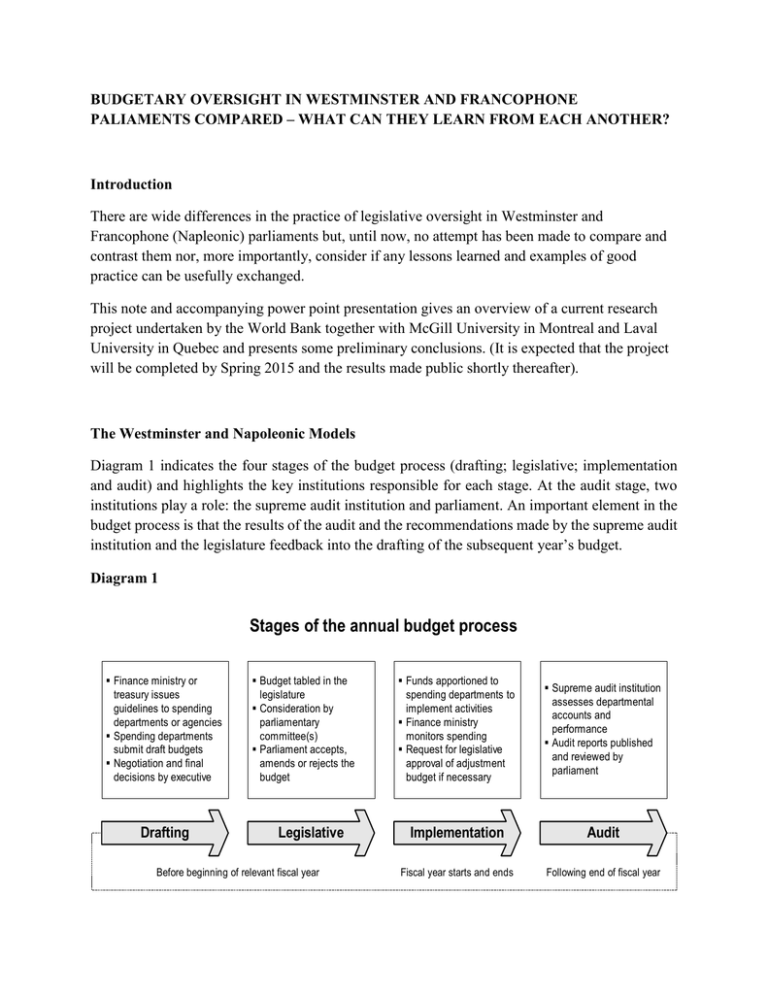what can they learn from each other?
advertisement

BUDGETARY OVERSIGHT IN WESTMINSTER AND FRANCOPHONE PALIAMENTS COMPARED – WHAT CAN THEY LEARN FROM EACH ANOTHER? Introduction There are wide differences in the practice of legislative oversight in Westminster and Francophone (Napleonic) parliaments but, until now, no attempt has been made to compare and contrast them nor, more importantly, consider if any lessons learned and examples of good practice can be usefully exchanged. This note and accompanying power point presentation gives an overview of a current research project undertaken by the World Bank together with McGill University in Montreal and Laval University in Quebec and presents some preliminary conclusions. (It is expected that the project will be completed by Spring 2015 and the results made public shortly thereafter). The Westminster and Napoleonic Models Diagram 1 indicates the four stages of the budget process (drafting; legislative; implementation and audit) and highlights the key institutions responsible for each stage. At the audit stage, two institutions play a role: the supreme audit institution and parliament. An important element in the budget process is that the results of the audit and the recommendations made by the supreme audit institution and the legislature feedback into the drafting of the subsequent year’s budget. Diagram 1 Stages of the annual budget process Finance ministry or treasury issues guidelines to spending departments or agencies Spending departments submit draft budgets Negotiation and final decisions by executive Drafting Budget tabled in the legislature Consideration by parliamentary committee(s) Parliament accepts, amends or rejects the budget Legislative Before beginning of relevant fiscal year Funds apportioned to spending departments to implement activities Finance ministry monitors spending Request for legislative approval of adjustment budget if necessary Supreme audit institution assesses departmental accounts and performance Audit reports published and reviewed by parliament Implementation Audit Fiscal year starts and ends Following end of fiscal year The relationship between legislatures and SAIs is often symbiotic. The legislature depends on the SAI submitting reliable and timely information, while the SAI depends on the legislature to provide a public forum for presenting and discussing audit results and any recommendations for corrective action. In many countries the constitution requires SAIs to be appointed by, and to report to, the legislature—thereby helping ensure their independence from the government. The legislature often approves the SAI’s budget, further reinforcing SAI independence. There are three broad SAI models: the Westminster model (also known as the Anglo-Saxon or parliamentary model), the Board or Collegiate model and the judicial or Napoleonic model. . There are numerous variations of these three models and recent reforms in many countries are leading to a convergence of functions, if not structure, of these three models. Here, the Westminster model and Napoleonic models are presented: Westminster Model In Westminster parliamentary systems, the legislature confers responsibility to the legislature, and the legislature in turn is accountable to the legislature; the Auditor General reviews the financial accounts of government and reports the legislature. See Diagram 3. The Auditor General works closely with a dedicated legislative committee (e.g., the Public Accounts Committee (PAC)) or sub-committee and may even provide the committees with special technical assistance. 1 This assistance might include preparing legislative proposals on state auditing, financial management or matters that have been the subject of major audits. Other (i.e. non-Westminster) parliamentary systems may use state audit committees, budget or finance committees. Napoleonic System By comparison with the Westminster model, the francophone approach to audit (Diagram 3) tends to be more convoluted, involving operation of separate controls by each of the three domains of government – administrative, judicial and parliamentary – and boundaries between internal and external controls can be blurred and inconsistent. Thus, in the francophone model the general state inspectorate (GSI) is the supreme body for administrative control, while judicial control is exercised through the cour des comptes and parliamentary control is achieved through the national assembly which assesses expenditures and passes the loi de reglement. Formally, the cour is not strictly an equivalent to the auditor general although, in combination, with the GSI it exercises a wider brief for auditing public finance than does the auditor general under the Westminster system. Diagram 2: The Westminster Model of Audit 1 It is important to note in this respect that while Public Accounts Committees (PACs) originate in the Westminster tradition and are a staple of parliamentary committee systems throughout the (British) Commonwealth, recent years have witnessed the establishment of PACs in countries with no British institutional legacy, such as Finland, Morocco, Indonesia, Kosovo and Thailand. PARLIAMENT Reports Accountability Conferred Responsibility AUDITOR GENERAL Diagram 3: The Napoleonic System Examines EXECUTIVE Although the GSI answers directly to the executive - and so is in effect an internal body in many countries it also has responsibility for overall audit of government expenditures - effectively assuming the SAI role - and therefore is involved with both internal and external parts of the auditing process. An argument used in defence of the Napoleonic system runs that while the GSI is technically answerable to the executive, it is able to remain independent from the ministries that it audits and so avoids conflicts of interest. The Cour des Comptes is an external body that is separate from the executive – as in the case of auditor general in the Westminster model. It scrutinizes the accounts of individual government departments and checks for compliance with the law, reporting to parliament on the overall wellbeing of the state accounts. Follow-up, however, is often limited and although the Cour is authorised to hold ministers liable for misused funds, it is a power that is rarely exercised. Although ultimately a division of the supreme court and technically independent from the legislature, in a number of countries Cour members are chosen by the president or prime minister. The ways in which the Cour des Comptes interacts with parliament are various, the World Bank2 identifying four different means by which dialogue between the two institutions might be instigated: 1) The president of the Cour des Comptes can use his own discretion to decide if and when to show the Cours’ findings to parliament. 2) A parliament committee can ask the Cour to conduct specific audits on a particular government department or financial management process. 3) The Cour publishes an annual report. 4) A separate document is issued whereby the Cour gives an annual report specifically produced for parliament concerning the use of the resources from the previous year’s finance act. What Explains These Differences? The project examines the two underlying administrative cultures behind the Westminster and Napoleonic systems (namely, common law and civil law, respectively) along four dimensions: the concept of the state, the concept of the role of public administration, careers within public administration, and notions of accountability. The Committee Process in the two systems The project examines the role and functions of the Public Accounts Committee, in the Westminster system and the Finance Commission (Committee) in Napoleonic systems, where the latter is 2 Titsworth, and Stapenhurst, PremNotes 59 (2001) charged not only with ex-post oversight but also with scrutiny of budget estimates. It considers the committee process along nine dimensions: A. Initiation of the Inquiry Process 1. Initiation of Process 2. Mandate B. Work of the Commission/PAC 3. Activities 4. Power to Question 5. Witnesses Called 6. Unanimity of Decisions C. Dissemination of Results 7. Inquiry Reports 8. Public Communications 9. Government Responses Synthesis of Results: Committee Autonomy As Table 1 indicates, the Napoleonic system seems to produce produce a weaker system of oversight than the Westminster system. The principal differences concern public communications and powers of the Committee; there is no significant difference for other issues. These results suggest that issues related to administration culture do not explain the differences between Napoleonic and Westminster systems; it is necessary to find other explanations… It would seem that the recommendations from several parliamentary strengthening organizations that non-Westminster parliaments should adopt the PACs as an instrument of budget oversight, regardless of the underlying system is misleading. Better would be to strengthen both Westminster and Napoleonic systems, with the latter (Napoleonic) learning how to improve public communications and powers of the Committee and the former (PACs) learning how to strengthen their mandate. Here, the Commonwealth Parliamentary Association and its francophone equivalents can play a critical role. Napoleonic Westminster 1. Initiation of Process High High 2. Mandate High Medium 3. Activities Weak High 4. Powers to Question Medium High 5. Witnesses Called High High 6. Unanimity od decisions High High 7. Inquiry Reports High High 8. Public Communications Weak Medium 9. Government responses Weak Weak TOTAL SCORE 11/18= 0.61 14/18 = 0.78 Inquiry Process Work of Committee Dissemination of results




